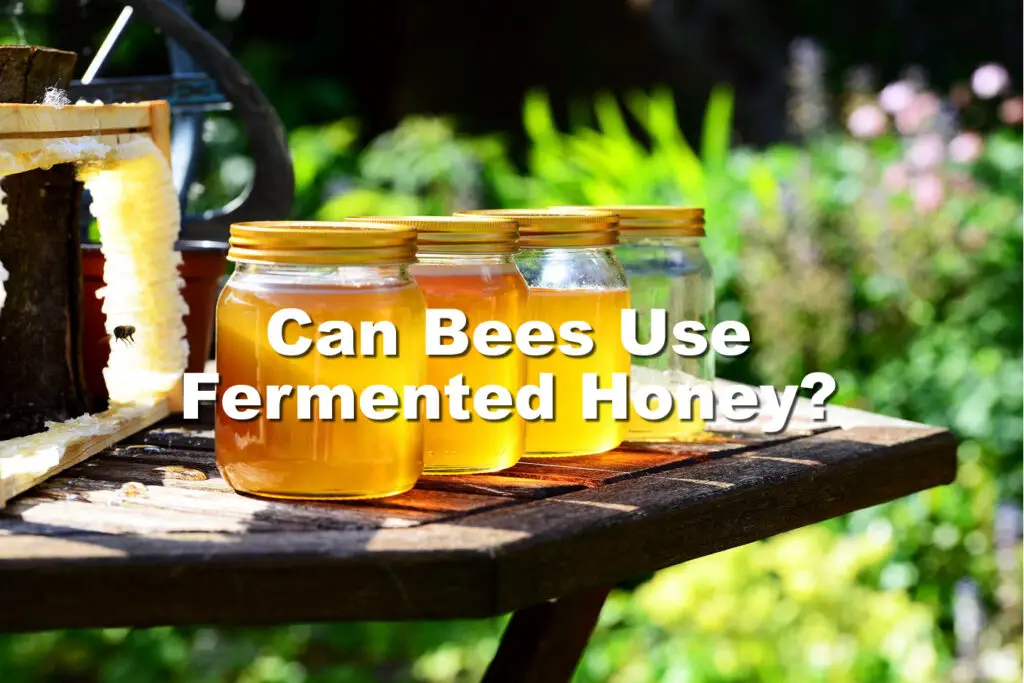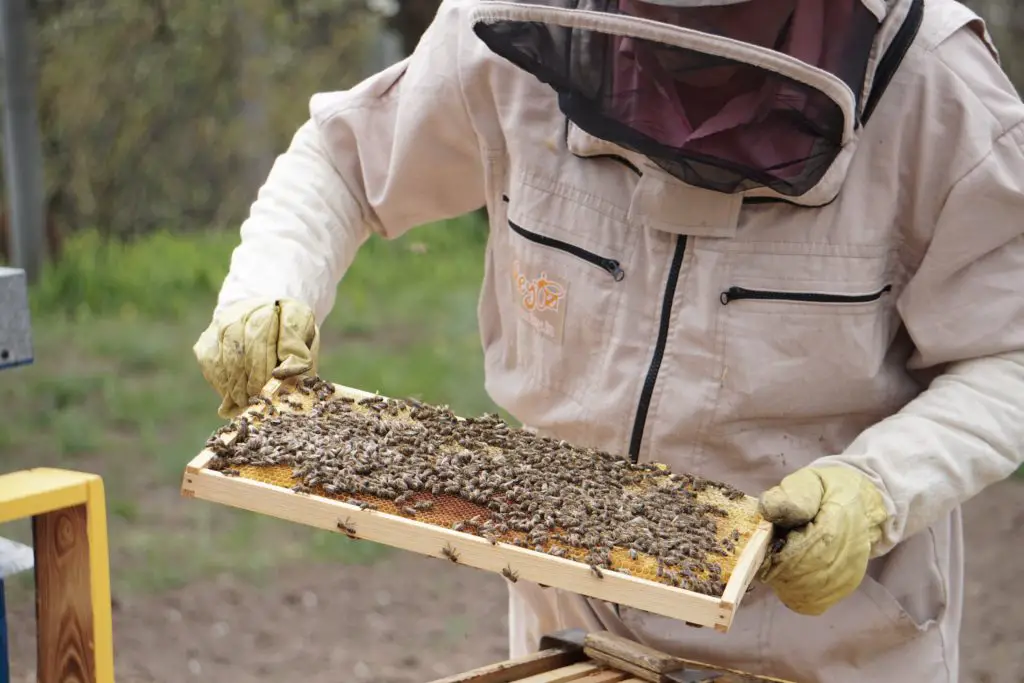Affiliate Disclaimer - As an Amazon Associate I earn from qualifying purchases.
It supports the website. So, Thank you
Honey can ferment in the hive. This happens when there is an uncapped cell which will contain nectar or honey that, over time, naturally ferments.
But even outside of natural fermentation, some beekeepers and nature enthusiasts will wonder whether they can offer fermented honey to a bee colony.
Fermented honey won’t do bees any harm as long as it remains a small part of their diet. Since it occurs naturally within the hive, it goes without saying that it isn’t immediately dangerous. However, since fermented honey is alcohol, too much can be a problem for your bees.
One of the main reasons that bees should not have too much fermented honey is that it can interfere with their digestion. Moreover, it’s one of the most common ways for bees to get dysentery which is a leading cause of the death of entire colonies.
Table of Contents
What Is Fermentation?
Fermentation is a process that involves carbohydrates being turned into carbon dioxide and ethanol; that’s the sciency bit. But to make it a little easier to understand, think about it like this; when honey ferments, it undergoes the same process that is used to brew alcoholic drinks.
The main difference in the brewery is that yeast is added into the mix. In the hive, yeast is still present but is a naturally occurring substance which is known as wild yeast.
Is Fermented Honey Safe For Bees?
The main issue with fermented honey is that it contains a certain amount of alcohol. This is a substance that is toxic to bees, as it is with pretty much any one animal on the planet. Did you know that alcohol is also toxic to humans which is why we are so harshly warned against consuming too much?
There is also reason to believe that consuming too much fermented honey can cause dysentery in bees which can be fatal. This disease affects the digestive system of the creature, most notably the colon, which becomes inflamed. Symptoms of dysentery include pain and diarrhoea although this probably won’t be something you notice until it’s too late. When not treated, dysentery is often the cause of the death of the entire hive.
Is Fermented Honey Safe For Humans?
Fermentation occurs when there is too much moisture in the honey. When you harvest your honey, the moisture content should be around 17.5%; any more than this and you’ll find that the product is likely to ferment over time. What’s more, when the moisture is kept around this level, you will notice that the consistency of the honey is far better.
That said, it is OK to eat fermented honey and one of the reasons that a lot of people like it is its intense flavor. This allows you to use it in recipes that require a bit more of a hit so it’s better than just throwing it away.
One great way to use it is to replace the need for regular honey and wine by just using fermented honey. In fact, many years ago, people would make mead, which is an alcoholic beverage, using fermented honey.
What’s great about mead is that it doesn’t take a long time to brew; perhaps four weeks or maybe a little longer. You can also make it sweet or dry according to your taste. For sweet mead, you typically need more honey for the recipe.
So, it appears that humans can eat fermented honey without any issues. However, if the honey is not clean or has been exposed to contaminants then there is a possibility that it would become unsafe to eat.
How Can I Tell Whether Honey Is Fermented?
One of the things you will need to learn to be a successful beekeeper is to be able to tell the difference between fermented and unfermented honey.
Fermented honey occurs when there are uncapped cells within the hive. In these cells, there may be honey, nectar, and sugar water; all of which can ferment over time if you do not remove them from the hive.
The good news is that fermentation, being a chemical process, is easy to spot. If you do notice fermentation within the hive, then it’s usually a good idea to remove the products as this will make space for the bees to produce more honey.
If you wish to remove the uncapped cells then you will simply need to shake the frame and they should quite easily fall out owing to their high water content. However, if this approach doesn’t work then you can use an extractor which is also a better option if you don’t want to damage the comb.
Before it starts to ferment, honey has a pretty standard appearance. It’ll have a golden hue to it and will be relatively clear. However, when the process of fermentation kicks in, the honey will be affected by carbon dioxide as well as naturally occurring yeast. The result is a liquid that starts to bubble. Eventually, it will begin to spill over the edges of the cell.
You will probably also be able to smell fermented honey as the carbon dioxide bubbles move to the surface. Unless you remove the fermented honey, the process will continue and before long, you will start to notice that the liquid begins to turn cloudy and takes on a white color. After this, it’ll begin to foam and start dripping down to the base of the hive.
Fermented Sugar Water
As well as the presence of fermented honey in your hive, you may also notice fermented sugar water. There are times that beekeepers need to offer additional nutrition to the hive and this often comes in the form of sugar water.
You might find that the bees don’t show any interest in sugar water once it has begun to ferment but other hives might, so it really depends on the colony. In any case, it’s probably best not to offer fermented sugar water to your bees, especially since it’s so quick and easy to produce a fresh batch.
If you aren’t sure whether the sugar water has started to ferment, one of the things you can check for is its scent. Once the yeast starts to develop, the sugar water will produce a pungent odor and this is one of the first giveaways that the process has begun. The liquid will turn cloudy which is another surefire sign. In some cases, there may be a clear presence of mold which, over time, will turn black.
How To Stop Honey From Fermenting In The Hive
Finding fermented honey in your bee hive is something that is unavoidable over the course of your beekeeping career. If you manage to never have any fermented honey then it might be by some sort of miracle.
What’s more, you may even gather your honey harvest only to find that the moisture content is too high and fermentation will be inevitable. However, through pasteurization, you can remove quite a bit of moisture which will lessen the chances of fermentation. Once you have done this, make sure that you store the honey in a sealed container to prevent any more moisture from getting in.
When pasteurizing your honey, it’s really important to make sure that you don’t heat it any higher than 95 degrees. If you do, then this will reduce the quality as the enzymes within the honey will be destroyed.
If you are supplementing your bees’ diets with sugar water then it is important to monitor the condition of the water to ensure it does not begin to ferment. You could simply keep an eye on things, replacing the water as needed or you might choose to add one of the following substances to reduce the chances of fermentation:
- Chlorine
- Bleach
- Apple cider vinegar
Conclusion
Bees use honey as a source of nutrition so it’s important that they always have access to it. Of course, there’s plenty within the hive but not all of it is suitable for your bees.
If honey contains too much water then it will begin to ferment over time. While this fermented honey isn’t dangerous to bees when consumed in small quantities, it will cause problems if they’re allowed to eat a lot of it.
This is because fermented honey contains alcohol, which is toxic to bees. The substance can cause digestive issues and may result in dysentery which could kill off the entire hive!














